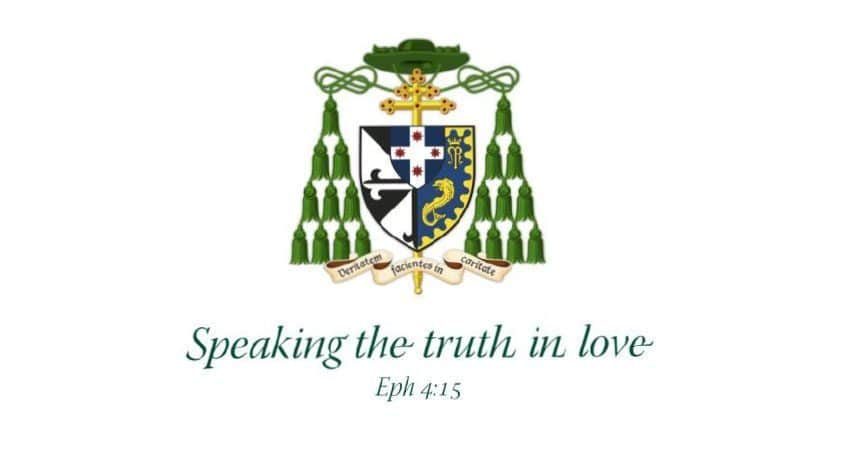HOMILY FOR SOLEMN MASS OF PENTECOST (YEAR B)

St. Mary’s Basilica, Sydney, 23 May 2021
Happy birthday! We gather today, as we would for any birthday party, so we can celebrate the Church’s birthday together. The Acts of the Apostles tell us that before Pentecost the disciples gathered in the upper room with Mary to pray for the wisdom to know what to do next (Acts 1:13-14). Then again on Pentecost day itself “the apostles all met in one room” (Acts 2:1-11). And then after Pentecost that the disciples “devoted themselves to the doctrine of the Apostles, to the common life, to the Breaking of the Bread, and to the prayers… holding their possessions in common, selling and giving to the poor… sharing their meals with glad and generous hearts” (Acts 2:42-47). So, from the beginning, Christians were a gathering people. The Spirit of Pentecost is the force for unity, the glue of that ἐκκλησία or assembly we call ‘the Church’.
After a year of separation, anxiety and lock-downs, we are free to gather for Mass. After a year of enforced ‘retreat’ the Spirit calls us back to the Eucharistic Breaking of the Bread and Eucharistic life of service. That’s why I have issued a pastoral letter calling all Catholics back to Mass and reflecting upon why gathering in person is so important for us. The Spirit calls each of us to come, not just today on our common birthday but every Sunday, not just alone but bringing others with us, as the celebration of Christmas-Easter-Pentecost is for every Sunday and for everyone.
Birthday parties aren’t just about gathering on an anniversary. We expect cakes, toasts, gifts. So, today’s celebration is marked by God the Father and Son giving us the Holy Spirit as our birthday present. He comes as wind and fire – typical Old Testament signs of God’s presence[1] – and fills everyone in the room (Acts 2:1-11). But does that mean that the Spirit is given indiscriminately?
Well, notice a detail from our report of Pentecost. In the Old Testament God is revealed in a burning bush or pillar of fire; in the Gospels, in a single human being Jesus. Yet today, Acts tells us, spiritual fire descends from heaven and separates into multiple tongues of flame, one for each person’s head. Each of us is individually and personally embraced by God, filled with grace, possessed by the Holy Spirit.
Which might explain why there are seven gifts of the Holy Spirit rather than one, and twelve fruits. We all need the gifts of Pentecost and Confirmation is the most dramatic Pentecosting of all. Yet we are very different people: one especially needs wisdom and understanding, another courage, one wants practical counsel or knowledge, another piety or reverence (Isa 11:1-2; CCC 1831 & 1845). When the spiritual gifts descend upon different heads (temperaments, histories, interests) the effects we call ‘fruits’ will sometimes be “love, joy or peace”, at other times “patience, kindness or goodness”, in one person “generosity, gentleness or fidelity”, in another “modesty, chastity and self-control” (cf. Gal 5:22-23; CCC 1832). In sending us the Spirit, Christ ensures each has the wherewithal to be the distinct kind of saint that God has destined them to be.
Pentecost, then, opens the last of three great acts in the drama of salvation history, the tale of a loving God coming ever closer to His creation, to us. In Part I, the Wisdom that is God the Son, joins the Father in the great act of creation (Prov 3:19-20; 8:22-36), while the Spirit hovers over the waters (Gen 1:2). In the second act, the Man that is the Son incarnate is identified at His Baptism by His Father’s voice and the Sprit hovers again over the waters and over Him. Christ having completed His saving work, we come to Part III: and just as Mary was there at the Annunciation for the descent of the Spirit, so she’s there for His return today. This time she is midwife to the Church.[2] The Spirit’s enlightens, inspires, puts fire in the belly, so the disciples can take the light of truth and warmth of love to the ends of the earth and till the end of the age.
There are some interesting symmetries or mirror images here, that would have immediately appealed to people in antiquity. For the ancients, the essence of beauty was balance, especially of contrasts.[3] One favourite technique was chiasmus, in which the colour or form of one side of an image or sculpture is inverted on the other side, perfectly balancing and reconciling polarities. The technique was found also in rhetoric, literature and music.
We find it in Aeschylus and Socrates, Shakespeare and Milton, through to Dylan Thomas, JFK and Dr Seuss. So, too, in scripture: Paul often uses chiastic structures, developing a theme first in one direction and then in reverse.[4] St Thomas Aquinas used the idea of exitus and reditus to frame his entire cosmology: all things come from God and are destined to return to God. He is their first and their final Cause. Christ’s mission is one grand arc of coming down from heaven through the self-emptying of Incarnation, Passion and Descent among the dead, then rising up to heaven through Resurrection and Ascension to the ever-living. All that sin has damaged and degraded, grace heals and elevates.
There’s a beautiful symmetry, also, about the mission of the Holy Spirit. Soon after the creation, in the book of human origins we call Genesis, we have the story of Babel (Gen 11:1-9), where the human race decides to build a tower up to heaven to make themselves gods. God responds to this vanity project by confounding their speech, so humanity is divided into rival tribes and languages, none understanding the other. Soon after the re-creation or redemption, in the book of Church’s origins we call Acts, is the story of Pentecost, a kind of photographic negative of Babel (Acts 2:1-41). The devout of every nation gather for the spring festival of Shavuot,[5] not to make themselves gods but to honour God as His children; the apostles gather with Mary in self-surrender and prayer. God responds to this humility project by giving them a shared spiritual language, so they understand each other as never before. Now the apostles can go out to all the world, telling the Good News, with confidence it will speak to people of all nations.
That’s the beauty of divine grace: it is the glue that holds us together and the inspiration that sends us out; it purifies us of our shortcomings and enables us to bear great fruits (Gal 5:16-25).
Sponsors, catechists, pastors, family and friends: today our candidates will receive the fire of Pentecost into their hearts. Help keep that flame alive by encouraging them in lives of Christian faith and practice, of virtue and holiness, of the worship of God and the love of all.
Dear candidates for Confirmation, in a few moments you will receive the seven-fold grace of God, and we pray it will be fruitful in your lives as missionary disciples. From now on you must demonstrate that love of the Father and the Son that is the Holy Spirit: in your words and deeds; by deepening your knowledge of Holy Scripture and Church teaching; by coming to Confession and Mass; and by works of mercy. The gifts of the Spirit, given in the Church, make every Sunday Christmas-Easter-Pentecost, and so you know where to come to be recharged, again and again. Come Holy Spirit!
[1] e.g. Ex 3:2; 13:21-22; Kings 5:24; Ps 104:3.
[2] Cf. Paul VI, Homily to the Extraordinary Assembly of Bishops, 25 October 1969 https://www.vatican.va/content/paul-vi/it/homilies/1969/documents/hf_p-vi_hom_19691025.html on Mary as spiritual midwife to the birth of the Church.
[3] Cf. Amanda Smith, “New exhibition highlights ancient Greek beauty ideals”, ABC, 6 August 2014, https://www.abc.net.au/radionational/programs/archived/bodysphere/new-exhibition-highlights-greek-beauty-ideal/5650086
[4] Rom 2:5-11; 14:13-23; 1Cor 1:19-29; 15:1-20; Col 1:15-20; Phil 2:5-11. Cf. https://biblicalchiasmus.wordpress.com/category/people-biblical/paul-the-apostle/; https://icucourses.com/pages/037-03-the-new-testament-st-pauls-hymns-of-christ
[5] cf. Ex 23:16; 34:22; Dt 16:9; Lev 23:16; Num 28:26.
Welcome to our celebration of the Feast of Pentecost at St Mary’s Basilica in Sydney. As The Gospel of Luke opens with the Descent of the Holy Spirit upon the Virgin Mary at the Annunciation, so Luke’s sequel The Acts of the Apostles opens with the descent of the Spirit upon the Apostles at Pentecost. The first descent led to the Incarnation, Birth and Mission of Christ; the second, to the ‘Incarnation’, Birth and Mission of the Church. And so we celebrate not only the Feast of the Holy Spirit but also the Feast of the Church today.
It is therefore a most fitting day on which to celebrate the Rite of Confirmation for adults in the Archdiocese of Sydney. It will be their Pentecost. I extend a very warm welcome to our candidates, sponsors, families and friends, and to all who will witness them taking this final step to full initiation as Catholics. As we prepare for this Mass our candidates challenge those of us who’ve already been fully initiated: how does being a fully-fledged member of the Church affect my character, imagination, beliefs, relationships, behaviour? To the extent that we have failed to live as God’s Spirit-filled people we repent of our sins…

